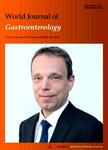Giant malignant gastrointestinal stromal tumors: Recurrence and effects of treatment with STI-571
Giant malignant gastrointestinal stromal tumors: Recurrence and effects of treatment with STI-571作者机构:DivisionofGeneralSurgeryDepartmentofSurgeryTri-ServiceGeneralHospitalNationalDefenseMedicalCenterTaipeiTaiwanChina DivisionofGastrointestinalMedicineDepartmentofInternalMedicineTri-ServiceGeneralHospitalNationalDefenseMedicalCenterTaipeiTaiwanChina DepartmentofSurgeryTungs'TaichungMetroharborHospitalTaichungTaiwanChina
出 版 物:《World Journal of Gastroenterology》 (世界胃肠病学杂志(英文版))
年 卷 期:2005年第11卷第2期
页 面:260-263页
核心收录:
学科分类:1002[医学-临床医学] 100214[医学-肿瘤学] 10[医学]
主 题:Giant malignant gastrointestinal stromal tumors STI-571
摘 要:AIM: Malignant gastrointestinal stromal tumors (GISTs)are rare. Tumors larger than 10 cm tend to recur earlier:the larger the volume of the tumor, the worse the *** hypothesized that treatment with imatinib mesylate (Gleevec; STI-571), a c-kittyrosine kinase inhibitor, as palliative therapy would prolong the survival of patients with recurrent giant malignant GISTs after ***: We performed a retrospective analysis of the effects of resection on patients with giant GISTs (10 cm in diameter) to determine the overall survival and recurrence rates. Twenty-three patients diagnosed with giant GISTs were included from June 1996 to December 2003. STI571 was not available until January 2000. After that time,9 patients received this drug. The factors of age, sex, tumor location, histological surgical margin, and STI-571, tumor size changes and drug side effects were reviewed. We compared the survival rate to determine the prognostic factors and the effects of STI-571 on patients with recurrent malignant gastrointestinal stromal ***: The positive surgical margin group had a significantly higher recurrence rate than the negative margin group (P = 0.012). A negative surgical margin and palliative treatment with STI-571 were significant prognostic variables (Log-rank test,P0.05). Age, sex and tumor location were not significant prognostic variables. The 5-year survival rate of the surgical margin free patients was 80%and the 2-year survival rate of the surgical margin positive patients was 28%. The 5-year survival rate was 80% for the patients given STI-571 and 30% for the patients not given STI-571. The use of STI-571 gave a significant tumor shrinkage (6/9) rate in patients with giant GIST recurrence after ***: A negative surgical margin and the use of STI-571 after surgical resection were good prognostic indicators. Achieving a tumor-free surgical margin is still the best primary treatment for patients with such *** STI-



